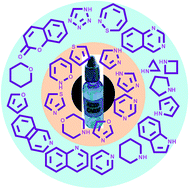Brønsted acid-promoted synthesis of common heterocycles and related bio-active and functional molecules
Abstract
Various heterocyclic systems based on natural and unnatural biologically active products were synthesized by Brønsted acid-promoted cyclization. We have made an attempt to summarize the progress made in this area during the period 2005 to 2015. This article describes the synthetic routes of these heterocycles that involve a Brønsted acid-promoted cyclization as a crucial step or Brønsted acids as co-catalysts with other transition metals.


 Please wait while we load your content...
Please wait while we load your content...